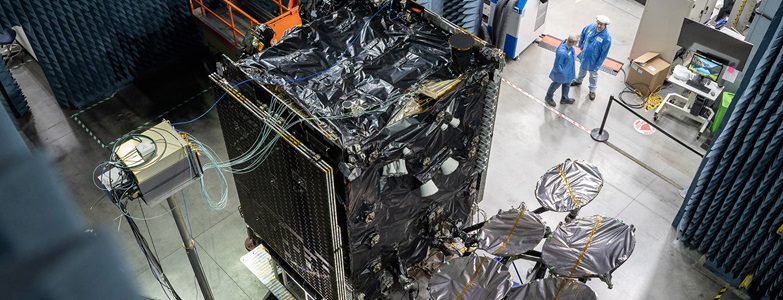Critical Connection
Unmatched Expertise Powers Protected Military Communications in Space
By David Larter
Satellite communication is so reliable and commonplace it’s easy for everyday users to take it for granted, whether watching live sports or checking email mid-flight.
Since the 1980s, militaries have also migrated to space-based communications systems — but ensuring the U.S. military and its allies have continuous communication capability is more complicated than providing cable television and internet service to consumers. Military satellite communications (MILSATCOM) systems need to fight through adversary jamming, operate despite ground station disruptions, withstand challenging environmental conditions, and mitigate an ever-growing set of attack approaches.
In short, protected MILSATCOM systems need to be no-fail — and no company has more experience in delivering on these stringent requirements than Northrop Grumman, said David Doami, senior director of MILSATCOM and Sustainment, pointing to decades of designing and delivering strategic SATCOM for the U.S. military.
“Our service members rely on assured, uninterrupted communication,” David said. “Commercial satellites and less protected military systems work in low-stakes environments but the threats to our systems are only getting more sophisticated. That’s why these next-generation systems are so vital.”
Decades in the Making
With each generation of MILSATCOM, capabilities have catapulted forward to address new requirements, said Terry Smigla, chief MILSATCOM engineer at Northrop Grumman.
Protected MILSATCOM has evolved from the earliest MILSTAR satellites, through the Advanced Extremely High Frequency (AEHF) satellites of the last decade, and now to new MILSATCOM systems in development, such as Northrop Grumman’s Evolved Strategic SATCOM (ESS) and Protected Tactical SATCOM (PTS) rapid prototypes.
“The requirements are driven by an ever-increasing demand for bandwidth and more sophisticated adversaries,” he said. “As the data rate goes up, you have to do more with the waveform and the onboard processing to provide anti-jam protection. Being protected isn’t just about threats in the electromagnetic spectrum, like jammers; we must also protect systems against on-orbit attacks.”
The software that runs MILSATCOM systems such as the MILSTAR and AEHF payloads is just as, if not more, important than the hardware that goes on orbit, Terry said. As demands have expanded, Northrop Grumman has continued to evolve the technology from the ground via software updates, he said.
Today’s protected MILSATCOM systems are more software-defined than ever, meaning they become more capable with each upgrade, Terry said.
“We know what it takes to keep protected MILSATCOM systems relevant; both our MILSTAR and AEHF payloads are far more capable now than when we first launched them,” he said. “That’s what we’re doing with the current generation of protected MILSATCOM as well, only we’re taking that capability to the next level. It’s a generational leap.”
Assured, Affordable Comms
No-fail missions, like missile defense and protected MILSATCOM, require diverse architectures with powerful satellites, said Blake Bullock, vice president of Military Space Systems at Northrop Grumman. But those satellites must exist in sufficient numbers and incorporate resiliency features to ensure the architecture can take a punch and keep operating.
That means keeping those systems affordable is a high priority, Blake said.
“In many instances, we can upgrade or repurpose existing technology for the next generation of systems at minimal additional cost, saving our investment dollars for technologies — like cutting-edge, software-defined processors — that keep the U.S. and our allies ahead of the threat,” she said. “That’s the benefit of having performed this mission for so long: We understand what legacy technology continues to be relevant and where we need to invest for the future.”
Leveraging existing technology was key to the recently launched Arctic Satellite Broadband Mission (ASBM), an historic Northrop Grumman-primed international space mission that included both commercial and U.S. military payloads on the same satellite for the first time.
This collaboration between the U.S. Space Force, Space Norway and Northrop Grumman resulted in the Enhanced Polar System – Recapitalization (EPS-R) program. The partnership delivered expanded protected MILSATCOM capability to the Arctic which, according to a public Space Force estimate, saved the taxpayer around $900 million.
As the company continues to advance MILSATCOM and find innovative ways of incorporating existing technologies, Northrop Grumman’s decades of on-orbit experience are the key to rapidly and affordably providing our warfighters this vital mission capability, David said.
“It comes down to mission mastery,” he said. “There is no substitute for the experience we’ve garnered performing the mission on orbit for more than 30 years.”
Learn more about how our innovations in MILSATCOM are securing the future for the U.S. and its allies.


